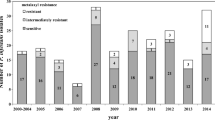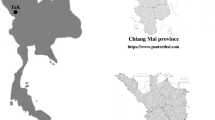Summary
Nineteen races were found among 116 isolates ofPhytophthora infestans recovered from French potato and tomato crops during 1991–1993. The most common races were 1.3.4.7.11. 1.3.4.7.8.11 and 1.3.4.7.10.11 in 1991, race 1.3.4.7.11 in 1992, and race 1.3.4.7.10.11 in 1993. None of the isolates was virulent to either R2 or R6, and only one to R5. The mean number of virulences per isolate was 5.78 in 1991, 4.35 in 1992 and 4.53 in 1993. TheP. infestans population from Brittany showed mainly quantitative changes in the frequencies of major races over the period investigated, but races identified were almost the same in all 3 years. No geographical substructure was apparent, since variation between locations accounted for only 13–22% of the total racial diversity within the Brittany population. This is interpretated as evidence for limited gene flow in this population, which is believed to have evolved from a few founding genotypes.
Similar content being viewed by others
References
Andrivon, D., C. Béasse & C. Laurent, 1993. Virulence, metalaxyl sensitivity, mating type and isozyme patterns in French isolates ofPhytophthora infestans. Abstracts, 12th Triennal Conference of the EAPR. Paris, France. pp 20–21.
Andrivon, D., C. Béasse & C. Laurent, 1994. Characterization of isolates ofPhytophthora infestans collected in northwestern France from 1988 to 1992.Plant Pathology 43: 471–478.
Anonymous, 1991. Surfaces en multiplication de plant, 1991. Fédération Nationale des Producteurs de Plants de Pomme de Terre, Paris.
Fry, W.E., S.B. Goodwin, A.T. Dyer, J.M. Matuszak, A. Drenth, P.W. Tooley, L.S. Sujkowski, Y.J. Koh, B.A. Cohen, L.J. Spielman, K.L. Deahl, D.A. Inglis & K.P. Sandlan, 1993. Historical and recent migrations ofPhytophthora infestans: chronology, pathways, and implications.Plant Disease 77: 653–661.
Fry, W.E., S.B. Goodwin, J.M. Matuszak, L.J. Spielman, M.G. Milgroom & A. Drenth, 1992. Population genetics and intercontinental migrations ofPhytophthora infestans.Annual Review of Phytopathology 30: 107–129.
Goodwin, S.B., R.W. Allard, S.A. Hardy & R.K. Webster, 1992. Hierarchical structure of pathogenic variation amongRhynchosporium secalis populations in Idaho and Oregon.Canadian Journal of Botany 70: 810–817.
Götz, E., 1986. Die Etablierung der Wirt-Pathogen Beziehung Kartoffel-Phytophthora infestans (Mont.) de Bary in vitro-ein Beitrag zur Pathotypen- und Resistenzprüfung. Ph.D. thesis, Berlin.
Götz, E., 1987. Das Pathotypenspektrum beiPhytophthora infestans (Mont.) de Bary, dem Erreger der Kraut- und Braunfäule der Kartoffel.Nachrichtenblatt für den Pflanzenschutz in der DDR 41: 119–121.
Groth, J.V. & A.P. Roelfs, 1987. The concept and measurement of phenotypic diversity inPuccinia graminis on wheat.Phytopathology 77: 1395–1999.
Gürtler, H., 1984. Physiological races ofPhytophthora infestans in Denmark and low temperature storage of isolates.Potato Research 27: 25–31.
O'Sullivan, E. & L.J. Dowley, 1983. Physiological specialization in strains ofPhytophthora infestans sensitive and resistant to metalaxyl.Irish Journal of Agricultural Research 22: 105–107.
Rullich, G. & B. Schöber, 1988. Auftreten und Verbreitung des A2 Paarungstyps vonPhytophthora infestans (Mont.) de Bary in der Bundesrepublik Deutchland.Der Kartoffelbau 39: 244–246.
Schöber, B. & L.J. Turkensteen, 1992. Recent and future developments in potato fungal pathology.Netherlands Journal of Plant Pathology 98, suppl. 2: 73–83.
Spielman, L.J., A. Drenth, L.C. Davidse, L.J. Sujkowski, W. Gu, P.W. Tooley & W.E. Fry, 1991. A second world-wide migration and population displacement ofPhytophthora infestans? Plant Pathology 40: 422–430.
Spielman, L.J., J.A. Sweigard, R.C. Shattock & W.E. Fry, 1990. The genetics ofPhytophthora infestans: segregation of allozyme markers in F2 and backcross progeny and the inheritance of virulence against potato resistance genes R2 and R4 in F1 progeny.Experimental Mycology 14: 57–69.
Wastie, R.L., 1991. Breeding for resistance. In: D.S. Ingram & P.H. Williams (Eds),Phytophthora infestans, the cause of late blight of potato.Advances in Plant Pathology 7: 193–224.
Author information
Authors and Affiliations
Rights and permissions
About this article
Cite this article
Andrivon, D. Races ofPhytophthora in festans in France, 1991–1993. Potato Res 37, 279–286 (1994). https://doi.org/10.1007/BF02360520
Accepted:
Issue Date:
DOI: https://doi.org/10.1007/BF02360520




